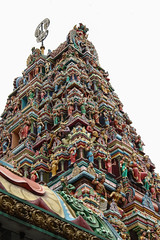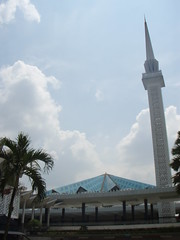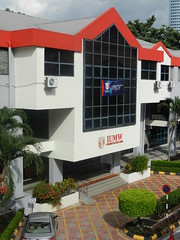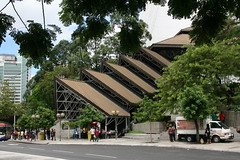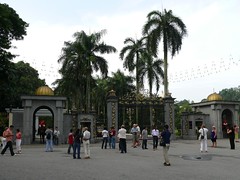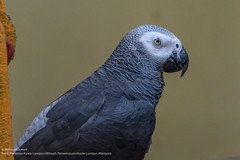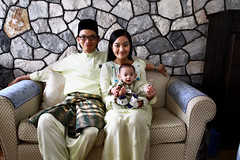Kuala Lumpur
Kuala Lumpur , officially the Federal Territory of Kuala Lumpur (Malay: Wilayah Persekutuan Kuala Lumpur) and colloquially referred to as KL, is a federal territory and the ceremonial, legislative and judicial capital city of Malaysia. It is one of the fastest growing cities in Asia and the largest city in Malaysia, covering an area of with a census population of 1,982,112 . Greater Kuala Lumpur, also known as the Klang Valley, is an urban agglomeration of 7.564 million people . It is among the fastest growing metropolitan regions in Southeast Asia, both in population and economic development.
The city serves as the cultural, financial, and economic centre of Malaysia. It is also home to the Parliament of Malaysia, and the Istana Negara, the official residence of the Yang di-Pertuan Agong (monarch of Malaysia). Kuala Lumpur first developed around 1857 as a town serving the tin mines of the region and served as the capital of Selangor from 1880 until 1978. Kuala Lumpur was the founding capital of the Federation of Malaya and its successor Malaysia, and the city remained the seat of the executive and judicial branches of the Malaysian federal government until these were relocated to Putrajaya in early 1999. However, some sections of the political bodies still remain in Kuala Lumpur. The city is one of the three federal territories of Malaysia, enclaved within the state of Selangor, on the central west coast of Peninsular Malaysia.
Since the 1990s, the city has played host to many international sporting, political and cultural events including the 1998 Commonwealth Games and the 2017 Southeast Asian Games. Kuala Lumpur has undergone rapid development in recent decades and is home to the tallest twin buildings in the world, the Petronas Towers, which have since become an iconic symbol of Malaysian development. Kuala Lumpur is well connected with neighboring urban regions such as Petaling Jaya via the rapidly-expanding Klang Valley Integrated Transit System. Residents of the city can also travel to other parts of Malaysia through KL Sentral.
Kuala Lumpur is one of the leading cities in the world for tourism and shopping, the 6th most-visited city in the world in 2019. The city houses three of the world's ten largest shopping malls. Kuala Lumpur ranks 70th in the world and second in Southeast Asia for Economist Intelligence Unit's Global Liveability Ranking and ninth in ASPAC and second in Southeast Asia for KPMG's Leading Technology Innovation Hub 2021. Kuala Lumpur was named World Book Capital 2020 by UNESCO.
Etymology
Kuala Lumpur means "muddy confluence" in Malay; Kuala is the point where two rivers join or an estuary, and lumpur means "mud". One suggestion is that it was named after Sungai Lumpur ("muddy river"); in the 1820s a place named Sungei Lumpoor was said to be the most important tin-producing settlement up the Klang River. However this derivation does not account for this: Kuala Lumpur lies at the confluence of Gombak River and Klang River, and therefore should be named Kuala Gombak, since the kuala is typically named after the river that joins a larger river or the sea. Some have argued that Sungai Lumpur in fact extended down to the confluence and therefore the point where it joined the Klang River would be Kuala Lumpur, although this Sungai Lumpur is said to be another river joining the Klang River upstream from the Gombak confluence, or perhaps located to the north of the Batu Caves area.
It has also been proposed that Kuala Lumpur was originally named Pengkalan Lumpur ("muddy landing place") in the same way that Klang was once called Pengkalan Batu ("stone landing place"), but became corrupted into Kuala Lumpur. Another theory says that it was initially a Cantonese word, lam-pa, meaning 'flooded jungle' or 'decayed jungle'. There is no firm contemporary evidence for these suggestions other than anecdotes. The name may also be a corrupted form of an earlier forgotten name.
History
Early years
No one specifically knows who founded or named Kuala Lumpur. Chinese miners were involved in tin mining up the Selangor River in the 1840s about north of present-day Kuala Lumpur, and Mandailing Sumatrans led by and Sutan Puasa were also involved in tin mining and trade in the Ulu Klang region before 1860, and Sumatrans may have settled in the upper reaches of Klang River in the first quarter of the 19th century, or possibly earlier. Kuala Lumpur was originally a small hamlet of just a few houses and shops at the confluence of the Sungai Gombak and Sungai Klang (Klang River). Kuala Lumpur became established as a town circa 1857, when the Malay Chief of Klang, Raja Abdullah bin Raja Jaafar, aided by his brother Raja Juma'at of Lukut, raised funds from Malaccan Chinese businessmen to hire Chinese miners from Lukut to open new tin mines there. The miners landed at Kuala Lumpur and continued on foot to Ampang, where they opened the first mine. Kuala Lumpur was the furthest point up the Klang River to which supplies could conveniently be brought by boat, and therefore became a collection and dispersal point serving the tin mines.
Despite a high death toll from the malarial conditions of the jungle, the Ampang mines succeeded, and exported the first tin in 1859. At that time, Sutan Puasa was already trading near Ampang. Two traders from Lukut, Hiu Siew and Yap Ah Sze, arrived in Kuala Lumpur and set up shops to sell provisions to miners in exchange for tin. The town, spurred on by tin-mining, started to develop around Old Market Square (Medan Pasar), with roads radiating out towards Ampang as well as Pudu and Batu (the destinations became the names of these roads: Ampang Road, Pudu Road, and Batu Road), where miners had also begun to settle in, and Petaling and Damansara. The miners formed gangs and the gangs frequently fought in this period, particularly factions of Kuala Lumpur and Kanching, mainly over control of the best tin mines. Leaders of the Chinese community were conferred the title of Kapitan Cina (Chinese headman) by the Malay chief, and Hiu Siew, the early Chinese trader, became the first Kapitan of Kuala Lumpur. The third Chinese Kapitan of Kuala Lumpur, Yap Ah Loy, was appointed in 1868.
Important Malay figures of early Kuala Lumpur also included Haji Mohamed Tahir, who became the Dato Dagang ("chief of traders"). The Minangkabaus of Sumatra became another important group who traded and established tobacco plantations in the area. Notable Minangkabaus included their headman, Dato' Sati, Utsman Abdullah, and Haji Mohamed Taib, who was involved in the early development of Kampung Baru. The Minangkabaus were also significant socio-religious figures, for example Utsman bin Abdullah was the first kadi of Kuala Lumpur, as well as Muhammad Nur bin Ismail.
Beginning of modern Kuala Lumpur
Early Kuala Lumpur was a small town that suffered from many social and political problems – the buildings were made of wood and 'atap' (palm frond thatching). The buildings were prone to catching fire, and due to a lack of proper sanitation the town was plagued with diseases. It also suffered from a constant threat of flooding due to its location. The town became embroiled in the Selangor Civil War in part over control of revenue from the tin mines. Yap Ah Loy allied himself with and the Hai San secret society, they fought against a rival secret society, Ghee Hin, whom allied themselves with Raja Mahdi. Raja Asal and Sutan Puasa switched sides to Raja Mahdi, and Kuala Lumpur was captured in 1872 and burnt to the ground. Yap escaped to Klang where he assembled another fighting force and recaptured Kuala Lumpur in March 1873, defeating Raja Mahdi's forces with the help of fighters from Pahang. The war and other setbacks, such as dropping tin prices, led to a slump. A major outbreak of cholera caused many to flee. The slump lasted until late 1879, when rising prices for tin allowed the town to recover. In late 1881, the town was severely flooded, after a fire that had destroyed the entire town in January. With the town being rebuilt a few times and having thrived, this was due in large to Yap Ah Loy. Yap, together with Frank Swettenham who was appointed the Resident in 1882, were the two most important figures of early Kuala Lumpur with Swettenham credited with its rapid growth and development and its transformation into a major urban centre.
The early Chinese and Malay settled along the east bank of the Klang River. The Chinese mainly settled around the commercial centre of Market Square. The Malays, and later Indian Chettiars and Muslims, resided in the Java Street area, now Jalan Tun Perak. In 1880, the colonial administration moved the state capital of Selangor from Klang to the more strategically advantageous Kuala Lumpur, and British Resident William Bloomfield Douglas decided to locate the government buildings and living quarters to the west of the river. Government offices and a new police headquarters were built on Bukit Aman, and the Padang initially created for police training. The Padang, now known as Merdeka Square, would later become the centre of the British administrative offices when the colonial government offices moved to the Sultan Abdul Samad Building in 1897.
Frank Swettenham, on becoming the British Resident, began improving the town by cleaning up the streets. He also stipulated in 1884 that buildings should be constructed of brick and tile so that they would be less flammable, and that the town be rebuilt with wider streets to reduce fire risk. Kapitan Yap Ah Loy bought a sprawling piece of real estate to set up a brick factory for the rebuilding of Kuala Lumpur, the eponymous Brickfields. Demolished atap buildings were replaced with brick and tile buildings, and many of the new brick buildings had "five-foot ways" and Chinese carpentry work. This resulted in a distinct eclectic shop house architecture typical to this region. Kapitan Yap Ah Loy expanded road access, linking tin mines with the city with th…
Looking for places related to Kuala Lumpur?
Those are other destinations to find places related to Kuala Lumpur:


